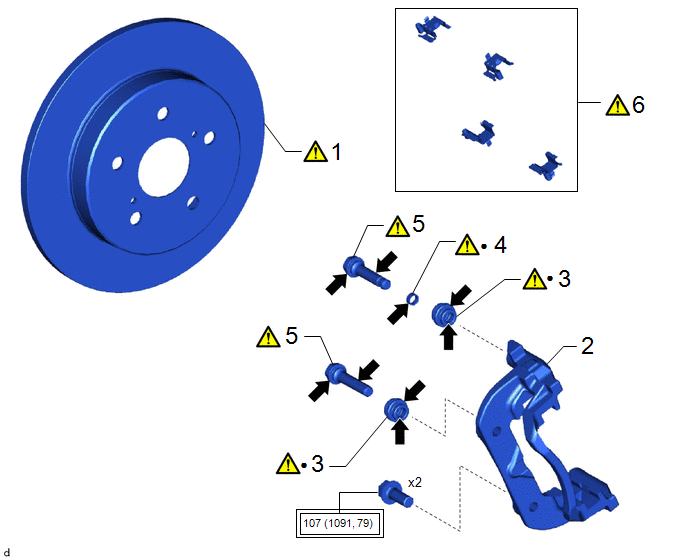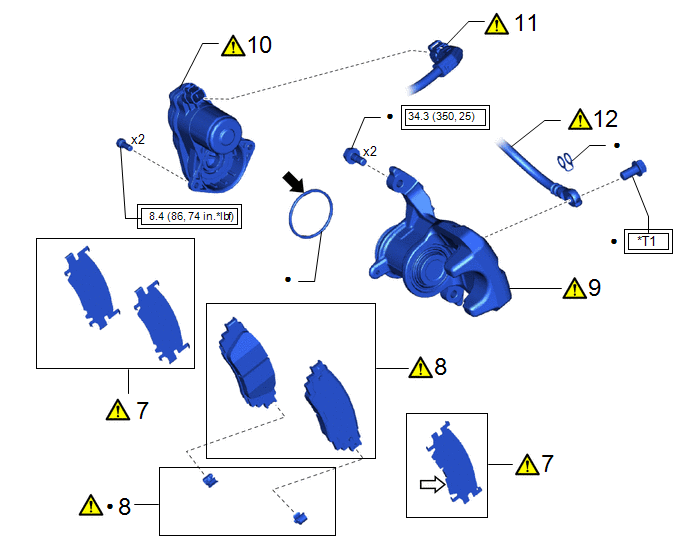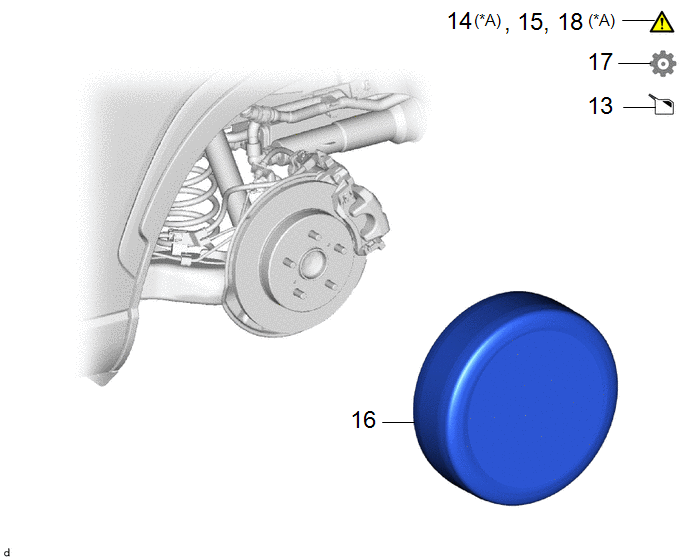Toyota Corolla Cross: Installation
INSTALLATION
CAUTION / NOTICE / HINT
COMPONENTS (INSTALLATION)
|
Procedure |
Part Name Code |
.png) |
.png) |
.png) |
|
|---|---|---|---|---|---|
|
1 |
REAR DISC |
42431 |
|
- |
- |
|
2 |
REAR DISC BRAKE CYLINDER MOUNTING |
- |
- |
- |
- |
|
3 |
REAR DISC BRAKE BUSHING DUST BOOT |
- |
|
- |
- |
|
4 |
REAR DISC BRAKE CYLINDER SLIDE BUSH |
- |
|
- |
- |
|
5 |
REAR DISC BRAKE CYLINDER SLIDE PIN |
- |
|
- |
- |
|
6 |
REAR DISC BRAKE PAD SUPPORT PLATE |
- |
|
- |
- |
.png) |
Tightening torque for "Major areas involving basic vehicle performance such as moving/turning/stopping": N*m (kgf*cm, ft.*lbf) |
● |
Non-reusable part |
.png) |
Lithium soap base glycol grease |
- |
- |

|
Procedure |
Part Name Code |
.png) |
.png) |
.png) |
|
|---|---|---|---|---|---|
|
7 |
REAR DISC BRAKE ANTI-SQUEAL SHIM KIT |
- |
|
- |
- |
|
8 |
REAR DICSC BRAKE PAD KIT |
04466 |
|
- |
- |
|
9 |
INSTALL DISC BRAKE CYLINDER ASSEMBLY |
- |
|
- |
- |
|
10 |
PARKING BRAKE ACTUATOR ASSEMBLY |
46310B |
|
- |
- |
|
11 |
NO. 2 PARKING BRAKE WIRE ASSEMBLY |
890C0A |
|
- |
- |
|
12 |
REAR FLEXIBLE HOSE |
- |
|
- |
- |
|
*T1 |
for 2WD: 29 N*m (296 kgf*cm, 21 ft.*lbf) for AWD: 30.4 N*m (310 kgf*cm, 22 ft.*lbf) |
- |
- |
.png) |
Tightening torque for "Major areas involving basic vehicle performance such as moving/turning/stopping": N*m (kgf*cm, ft.*lbf) |
● |
Non-reusable part |
.png) |
Lithium soap base glycol grease |
 |
Disc Brake Grease |

|
Procedure |
Part Name Code |
.png) |
.png) |
.png) |
|
|---|---|---|---|---|---|
|
13 |
BLEED BRAKE LINE |
- |
- |
|
- |
|
14 |
DISC BRAKE CYLINDER ASSEMBLY (for HEV Model) |
- |
|
- |
- |
|
15 |
DISC BRAKE CYLINDER ASSEMBLY (for Gasoline Model) |
- |
|
- |
- |
|
16 |
REAR WHEEL |
- |
- |
- |
- |
|
17 |
NORMAL CONDITION RECOVERY |
- |
- |
- |
|
|
18 |
INITIALIZATION AFTER RECONNECTING AUXILIARY BATTERY TERMINAL |
- |
|
- |
- |
|
*A |
for HEV Model |
- |
- |
CAUTION / NOTICE / HINT
NOTICE:
- Immediately after installing the rear disc brake pads, the braking performance may be reduced. Always perform a road test in a safe place while paying attention to the surroundings.
- After replacing the rear disc brake pads, the brake pedal may feel soft due to clearance between the rear disc brake pads and rear disc. Depress the brake pedal several times until the brake pedal feels firm.
- After replacing the rear disc brake pads, always perform a road test to check the braking performance and check for vibrations.
- When removing or installing the rear disc brake cylinder assembly, pushing back the disc brake piston may cause a large clearance between the brake pads and brake disc. When the brake pedal is depressed with a large clearance between the brake pads and the brake disc, DTCs related to abnormal brake fluid pressure may be stored.Make sure to clear any DTCs after performing this procedure. (for HEV Model)
- While the auxiliary battery is connected, even if the ignition switch is off, the brake control system activates when the brake pedal is depressed or any door courtesy switch turns on. Therefore, when servicing the brake system components, do not operate the brake pedal or open/close the doors while the auxiliary battery is connected. (for HEV Model)
HINT:
- Use the same procedure for the RH side and LH side.
- The following procedure is for the LH side.
PROCEDURE
1. INSTALL REAR DISC
.png) |
NOTICE: When replacing the rear disc with a new one, select the installation position where the rear disc has minimal runout. |

|
*a |
Matchmark |
- |
- |
(1) Align the matchmarks of the rear disc and rear axle hub and bearing assembly, and install the rear disc.
NOTICE:
When replacing the rear disc with a new one, select the installation position where the rear disc has minimal runout.
2. INSTALL REAR DISC BRAKE CYLINDER MOUNTING
Torque:
107 N·m {1091 kgf·cm, 79 ft·lbf}
3. INSTALL REAR DISC BRAKE BUSHING DUST BOOT

.png) |
Lithium Soap Base Glycol Grease |
- |
- |
(1) Apply a light layer of lithium soap base glycol grease to the entire circumference of 2 new rear disc brake bushing dust boots.
HINT:
Apply more than 0.3 g (0.01 oz) of lithium soap base glycol grease to each rear disc brake bushing dust boot.
(2) Install the 2 rear disc brake bushing dust boots to the rear disc brake cylinder mounting.
4. INSTALL REAR DISC BRAKE CYLINDER SLIDE BUSH

.png) |
Lithium Soap Base Glycol Grease |
- |
- |
(1) Apply a light layer of lithium soap base glycol grease to the contact surface of the rear No. 2 disc brake cylinder slide pin.
(2) Install a new rear disc brake cylinder slide bushing to the rear No. 2 disc brake cylinder slide pin.
5. INSTALL REAR DISC BRAKE CYLINDER SLIDE PIN

|
*1 |
Rear No. 1 Disc Brake Cylinder Slide Pin |
*2 |
Rear No. 2 Disc Brake Cylinder Slide Pin |
.png) |
Lithium Soap Base Glycol Grease |
- |
- |
(1) Apply a light layer of lithium soap base glycol grease to the sliding part and the sealing surfaces of the rear No. 1 disc brake cylinder slide pin and rear No. 2 disc brake cylinder slide pin.
(2) Install the rear No. 1 disc brake cylinder slide pin and rear No. 2 disc brake cylinder slide pin to the rear disc brake cylinder mounting.
(3) Push the rear No. 1 disc brake cylinder slide pin and rear No. 2 disc brake cylinder slide pin into each rear disc brake bushing dust boot to engage the pins to the boots.
6. INSTALL REAR DISC BRAKE PAD SUPPORT PLATE
.png) |
NOTICE: Be sure to install each rear disc brake pad support plate in the correct position and direction. |
7. INSTALL REAR DISC BRAKE ANTI-SQUEAL SHIM KIT
.png) |
Click here |
8. INSTALL REAR DICSC BRAKE PAD KIT
(a) Install the 2 rear disc brake pads to the rear disc brake cylinder mounting.
NOTICE:
Install the rear disc brake pad so that the rear disc brake pad wear indicator plate is mounted on the lower side of the vehicle.
HINT:
If the rear disc brake pad has an identification mark, be sure to confirm the installation location.

|
*a |
Inner Side (Orange) |
*b |
Outer Side (Yellow green) |
9. INSTALL DISC BRAKE CYLINDER ASSEMBLY
.png) |
NOTICE: If bleeding of air from the rear brake cylinder assembly will be performed, reuse the bolts. If bleeding of air from the rear brake cylinder assembly will not be performed, install new bolts. |
Torque:
34.3 N·m {350 kgf·cm, 25 ft·lbf}
10. INSTALL PARKING BRAKE ACTUATOR ASSEMBLY
.png) |
Click here |
11. CONNECT NO. 2 PARKING BRAKE WIRE ASSEMBLY
.png) |
Click here |
12. CONNECT REAR FLEXIBLE HOSE
.png) |
NOTICE: Install the rear flexible hose lock securely into the lock hole in the rear disc brake cylinder assembly. |
Torque:
for 2WD : :
29 N·m {296 kgf·cm, 21 ft·lbf}
for AWD : :
30.4 N·m {310 kgf·cm, 22 ft·lbf}
13. BLEED BRAKE LINE
- for HEV Model: Click here
.gif)
- for Gasoline Model: Click here
.gif)
14. BLEED DISC BRAKE CYLINDER ASSEMBLY (for HEV Model)
.png) |
CAUTION: If the rear disc brake cylinder assembly has been disassembled, perform air bleeding for the rear disc brake cylinder assembly. HINT:
|

(1) Perform the following procedure.
1. Perform the procedure to enter rear disc brake pad replacement mode 5 times.
Click here .gif)
2. Disconnect the No. 2 parking brake wire assembly connector from the parking brake actuator assembly.
Click here .gif)
3. Hold the 2 rear disc brake cylinder slide pins and remove the 2 bolts and separate the rear disc brake cylinder assembly from the rear disc brake cylinder mounting.(*1)
4. Hold the rear disc brake cylinder assembly horizontally, then tilt it 45° toward the bleeder plug side as shown in the illustration.(*2)
5. Temporarily install the rear disc brake cylinder assembly to the rear disc brake cylinder mounting with the 2 bolts.(*3)
6. Remove the center cowl top ventilator louver.
Click here .gif)
7. Remove the brake master cylinder reservoir filler cap assembly.
Click here .gif)
8. Add brake fluid to keep the level between the MIN and MAX lines of the reservoir while bleeding the brakes.
NOTICE:
- Make sure that there is sufficient brake fluid in the reservoir.
- Do not remove the filter from the brake master cylinder reservoir assembly and be sure to fill the brake master cylinder reservoir assembly with new brake fluid to avoid any potential contamination of the brake system. Contamination, for example by dirt particles or mineral oil, could lead to functional brake problems.
- If brake fluid leaks onto any painted surface, immediately wash it off.
9. Remove the rear disc brake bleeder plug cap.
10. Connect a vinyl tube to the rear disc brake bleeder plug.
11. Depress the brake pedal several times, and then loosen the rear disc brake bleeder plug with the pedal depressed.(*4)
12. When fluid stops coming out, tighten the rear disc brake bleeder plug and release the brake pedal.(*5)
NOTICE:
Repeat steps (*4) through (*5) until there are no signs of air in the brake fluid.
13. Repeat steps (*1) through (*5) 3 times.
NOTICE:
If there is still air in the system after performing steps (*1) through (*5) 3 times, repeat the steps (*1) through (*5) until the air has been bled.
14. Tighten the rear disc brake bleeder plug completely.
Torque:
8.3 N·m {85 kgf·cm, 73 in·lbf}
15. Install the rear disc brake bleeder plug cap.
16. Hold the 2 rear disc brake cylinder slide pins, and install the rear disc brake cylinder assembly to the rear disc brake cylinder mounting with 2 new bolts.
Torque:
34.3 N·m {350 kgf·cm, 25 ft·lbf}
17. Connect the No. 2 parking brake wire assembly connector to the parking brake actuator assembly.
Click here .gif)
18. Inspect for brake fluid leaks.
19. Inspect the brake fluid level in the reservoir.
Click here .gif)
20. Install the brake master cylinder reservoir filler cap assembly.
Click here .gif)
21. Install the center cowl top ventilator louver.
Click here .gif)
15. BLEED DISC BRAKE CYLINDER ASSEMBLY (for Gasoline Model)
.png) |
CAUTION: If the rear disc brake cylinder assembly has been disassembled, perform air bleeding for the rear disc brake cylinder assembly. HINT:
|

(1) Perform the following procedure.
1. Perform the procedure to enter rear disc brake pad replacement mode 5 times.
Click here .gif)
2. Disconnect the No. 2 parking brake wire assembly connector from the parking brake actuator assembly.
Click here .gif)
3. Hold the 2 rear disc brake cylinder slide pins and remove the 2 bolts and separate the rear disc brake cylinder assembly from the rear disc brake cylinder mounting.(*1)
4. Hold the rear disc brake cylinder assembly horizontally, then tilt it 45° toward the bleeder plug side as shown in the illustration.(*2)
5. Temporarily install the rear disc brake cylinder assembly to the rear disc brake cylinder mounting with the 2 bolts.(*3)
6. Remove the center cowl top ventilator louver.
Click here .gif)
7. Remove the brake master cylinder reservoir filler cap assembly.
Click here .gif)
8. Add brake fluid to keep the level between the MIN and MAX lines of the reservoir while bleeding the brakes.
NOTICE:
- Make sure that there is sufficient brake fluid in the reservoir.
- Do not remove the filter from the brake master cylinder reservoir assembly and be sure to fill the brake master cylinder reservoir assembly with new brake fluid to avoid any potential contamination of the brake system. Contamination, for example by dirt particles or mineral oil, could lead to functional brake problems.
- If brake fluid leaks onto any painted surface, immediately wash it off.
9. Remove the rear disc brake bleeder plug cap.
10. Connect a vinyl tube to the rear disc brake bleeder plug.
11. Depress the brake pedal several times, and then loosen the rear disc brake bleeder plug with the pedal depressed.(*4)
12. When fluid stops coming out, tighten the rear disc brake bleeder plug and release the brake pedal.(*5)
NOTICE:
Repeat steps (*4) through (*5) until there are no signs of air in the brake fluid.
13. Repeat steps (*1) through (*5) 3 times.
NOTICE:
If there is still air in the system after performing steps (*1) through (*5) 3 times, repeat the steps (*1) through (*5) until the air has been bled.
14. Tighten the rear disc brake bleeder plug completely.
Torque:
8.3 N·m {85 kgf·cm, 73 in·lbf}
15. Install the rear disc brake bleeder plug cap.
16. Hold the 2 rear disc brake cylinder slide pins, and install the rear disc brake cylinder assembly to the rear disc brake cylinder mounting with 2 new bolts.
Torque:
34.3 N·m {350 kgf·cm, 25 ft·lbf}
17. Connect the No. 2 parking brake wire assembly connector to the parking brake actuator assembly.
Click here .gif)
18. Inspect for brake fluid leaks.
19. Inspect the brake fluid level in the reservoir.
Click here .gif)
20. Install the brake master cylinder reservoir filler cap assembly.
Click here .gif)
21. Install the center cowl top ventilator louver.
Click here .gif)
16. INSTALL REAR WHEEL
Click here .gif)
17. NORMAL CONDITION RECOVERY
- for HEV model:
Click here
.gif)
- for Gasoline model:
Click here
.gif)
18. INITIALIZATION AFTER RECONNECTING AUXILIARY BATTERY TERMINAL (for HEV Model)
HINT:
When disconnecting and reconnecting the auxiliary battery, there is an automatic learning function that completes learning when the respective system is used.
Click here .gif)


